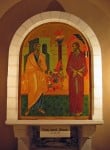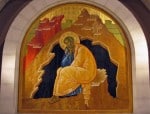Church of the Dormition of Mary
After class in the morning we had the afternoon free to go explore Mt. Zion. This area is just outside the present day walls (At the time of Jesus it was inside the city) to the south. This is a traditionally Christian area going all the way back to the early Church. The first site that I went to visit was the Church of the Dormition of Mary. The word “dormition” means “falling asleep”. This word is used because we don’t really know how Mary’s life ended. We know that she was taken to heaven, body and soul, but the Church has deliberately avoided saying whether she died or not. We don’t know, and theologians can debate about it. There is a very nice statue of Mary asleep in the crypt of the church and it makes for a good place to pray.
My next stop was at the Cenacle, the “Upper Room” of the Last Supper. In some cases we don’t really know for sure if a place is really the exact location for a particular event. However, with the case of the Cenacle, we can say with certainty that the present room is not the room. Whatever the original looked like, it was destroyed by the Romans and what we have today was built by the Crusaders. Still, the location may be the same spot. No matter its origins, this is the place that Christians have come for centuries to commemorate the events of the Last Supper, the Resurrection appearances, Pentecost, and others. Immediately below the Cenacle is what is supposedly the tomb of King David. It was interesting, but definitely not the tomb of David.
The final stop for the day was Mass at the church of St. Peter in Gallicantu. “Gallicantu” means “cockcrow” and is dedicated to Peter’s denial of Jesus on the night of his arrest. It is built on what are believed to be the ruins of the house of the high priest Caiaphas. Below the crypt is the jail where Jesus was held and outside are the 1st century steps that Jesus walked up from the Mt. of Olives. If you remember from the Bible, Peter was in the courtyard of the high priest while Jesus was being tried and it was there that he denied Jesus three times before the cock crowed.
1st Century Stairs to the House of Caiaphas
One of my favorite parts about this church is down in the crypt church. They have 3 icons of the life of St. Peter. The first one depicts Peter’s denial and says “I don’t know him.” The middle one in the sanctuary shows Peter weeping and says “And Peter went out and wept bitterly.” The final one on the right shows Peter with Jesus by the seashore after the resurrection saying, “You know all things; you know that I love you.” It’s a powerful display of the conversion of St. Peter. My thoughts went back to my time at the church in Galilee where Peter spoke those last words. What an amazing saint Peter is. How amazing God’s forgiveness is!







